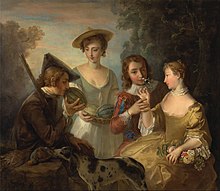This article has multiple issues. Please help improve it or discuss these issues on the talk page. (Learn how and when to remove these template messages)
|


Olfactic communication is a channel of nonverbal communication referring to the various ways people and animals communicate and engage in social interaction through their sense of smell. Our human olfactory sense is one of the most phylogenetically primitive[1] and emotionally intimate[2] of the five senses; the sensation of smell is thought to be the most matured and developed human sense.
Human ancestors essentially depended on their sense of smell to alert themselves of danger such as poisonous food and to locate potent mating partners. Using the sense of smell as an instrument paved a way for smell to become a platform of nonverbal communication. Smell also has a significant influence on social interactions. Through their branch of olfaction research, the National Science Foundation recorded that over 70 percent of American adults believe a person's body odor has a significant effect on how interested they will be when conversing with people of a different sex.[3] This process is possible with olfactory bulbs, the part of the brain that discriminates and enhances certain odors. Typically, women will prefer men whose natural odor is similar to their own, while heterosexual men are attracted to females with high estrogen levels and strong menstrual secretions.[4] An entire industry has been developed to provide people with personal smell-masking products, such as perfume, cologne, deodorant, and scented lotions. When a person covers their natural body odor with a pleasant smell, they are communicating their desire to be attractive either emotionally, sexually, or romantically.[3]
- ^ Brill AA (1932-01-01). "The Sense of Smell in the Neuroses and Psychoses". The Psychoanalytic Quarterly. 1 (1): 7–42. doi:10.1080/21674086.1932.11925133. ISSN 0033-2828.
- ^ Krusemark EA, Novak LR, Gitelman DR, Li W (September 2013). "When the sense of smell meets emotion: anxiety-state-dependent olfactory processing and neural circuitry adaptation". The Journal of Neuroscience. 33 (39): 15324–15332. doi:10.1523/JNEUROSCI.1835-13.2013. PMC 3782615. PMID 24068799.
- ^ a b Neuliep JW (2009). "The Nonverbal Code" (PDF). Intercultural Communication: A Contextual Approach (4th ed.). Los Angeles: Sage. ISBN 978-1-4129-6770-9.
- ^ Bontempi C, Jacquot L, Brand G (2021). "Sex Differences in Odor Hedonic Perception: An Overview". Frontiers in Neuroscience. 15: 764520. doi:10.3389/fnins.2021.764520. PMC 8558558. PMID 34733137.
© MMXXIII Rich X Search. We shall prevail. All rights reserved. Rich X Search
